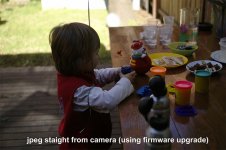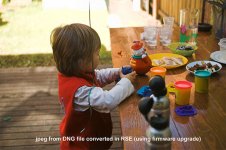hansori
Newbie
Hello,
I have recently purchased an R-D1 and I just love this thing.
I've been shooting everything RAW as I do with my other cameras, and noticed that the epson raw files act different (exposure-wise, more than anything) depending on what converter I am using.
I normally use CS2 ACR for 100% of work I do, however I noticed that when I open my epson raw files with CS2, the pictures looked way way underexposed (about 2 stops.) So I did my homework and done a little searching on this forum and found that the camera tends to underexpose a bit and this should be normal.
Hmmm
I went ahead and installed the software that came with the camera and found that when I open my raw files with the epson program, the exposures looked a bit better, but not a 100% (about 1 stop underexposed)
Now, when take a picture and view through the LCD on my R-D1 (plus the histogram) it looks perfectly well exposed, but when I open them in CS2 and the Epson raw converter, they come out underexposed?? Hmmmm
So after shooting test samples along with my main body (Canon 1Ds Mk2) and comparing them in photoshop, the underexposure started to bug me and got me thinking that perhaps my R-d1 is a lemon.
Then just out of curiosity I downloaded the free RawShooter converter and opened my epson raw files. Hmmmmm, wait, no underexposure! Every picture looked exactly the same as I viewed them through the LCD on the camera and they matched my 1Ds Mk2 files in terms of exposure.
So here's my question: is RawShooter the answer for R-d1 Raw files? I would love for this to be the answer but the colors don't come out as nice as CS2 or the epson converter. Sigh.
Appologies for the long first post
Best regards,
Sam
I have recently purchased an R-D1 and I just love this thing.
I've been shooting everything RAW as I do with my other cameras, and noticed that the epson raw files act different (exposure-wise, more than anything) depending on what converter I am using.
I normally use CS2 ACR for 100% of work I do, however I noticed that when I open my epson raw files with CS2, the pictures looked way way underexposed (about 2 stops.) So I did my homework and done a little searching on this forum and found that the camera tends to underexpose a bit and this should be normal.
Hmmm
I went ahead and installed the software that came with the camera and found that when I open my raw files with the epson program, the exposures looked a bit better, but not a 100% (about 1 stop underexposed)
Now, when take a picture and view through the LCD on my R-D1 (plus the histogram) it looks perfectly well exposed, but when I open them in CS2 and the Epson raw converter, they come out underexposed?? Hmmmm
So after shooting test samples along with my main body (Canon 1Ds Mk2) and comparing them in photoshop, the underexposure started to bug me and got me thinking that perhaps my R-d1 is a lemon.
Then just out of curiosity I downloaded the free RawShooter converter and opened my epson raw files. Hmmmmm, wait, no underexposure! Every picture looked exactly the same as I viewed them through the LCD on the camera and they matched my 1Ds Mk2 files in terms of exposure.
So here's my question: is RawShooter the answer for R-d1 Raw files? I would love for this to be the answer but the colors don't come out as nice as CS2 or the epson converter. Sigh.
Appologies for the long first post
Best regards,
Sam
pfogle
Well-known
I find I use RSE all the time now - I like the images better than C1, and they're both smoother and sharper than using EPR. Still, I think EPR gives the most film-like look, especially in b/w.
I generally convert first in RSE, then do another version using photo raw if I think it's worth it. For instance, using infra-red (hoya R72 filter) I get the best b/w using the built in epson b/w with green filter - it's better even than doing a color conversion and then using the channel mixer in PS. Don't know why, but there it is...
I generally convert first in RSE, then do another version using photo raw if I think it's worth it. For instance, using infra-red (hoya R72 filter) I get the best b/w using the built in epson b/w with green filter - it's better even than doing a color conversion and then using the channel mixer in PS. Don't know why, but there it is...
jlw
Rangefinder camera pedant
One thing to watch out for with ACR is that by default, it tries to make an "auto-levels" setting of each picture. Unfortunately, like all auto-exposure systems, it can be confused by light backgrounds, bright light sources within the frame, etc. This can lead to the image looking underexposed even if it really isn't.
Generally I start by viewing a batch of files in Adobe Bridge and, if I see a group that appears too dark, I select that group and turn the auto-levels setting OFF. Often that resolves the problem.
Generally I start by viewing a batch of files in Adobe Bridge and, if I see a group that appears too dark, I select that group and turn the auto-levels setting OFF. Often that resolves the problem.
Erl
Established
Sam,
Been down that path. Not at the end yet, but experimenting and probing does work.
On my RD-1, (I just did the firmware upgrade before shooting the attached pics) I now dial in maybe +1 exposure compensation when shooting anything against the light. See attached sample. More could be used, it varies in each case. The original jpeg created along with the RAW file on the RD-1 shows a real interpretation of the scene. The jpeg converted from the RAW file, to Adobe DNG and then converted to jpeg in RSE has been easily 'balanced' in RSE for a more pleasing look.
Just keep experimenting until you establish the 'look' you like. Not really different from using different developers with film to get what you want.
Been down that path. Not at the end yet, but experimenting and probing does work.
On my RD-1, (I just did the firmware upgrade before shooting the attached pics) I now dial in maybe +1 exposure compensation when shooting anything against the light. See attached sample. More could be used, it varies in each case. The original jpeg created along with the RAW file on the RD-1 shows a real interpretation of the scene. The jpeg converted from the RAW file, to Adobe DNG and then converted to jpeg in RSE has been easily 'balanced' in RSE for a more pleasing look.
Just keep experimenting until you establish the 'look' you like. Not really different from using different developers with film to get what you want.
Attachments
hansori
Newbie
Thanks for the replies. I did notice that the camera tends to expose for highlights rather than shadows. I prefer shadow noise over blown-out highlights so that's a good thing, I suppose.
As for the auto-function in ACR, I have them turned off by default and this can be done by tweaking the registry (please don't try this at home if you're not familiar with registry tweaking.)
My main concern was noise, as bringing up 2 stops in ACR would definitely create some shadow noise. However, I tested against RSE at normal exposure setting (no post compensation) and the noise levels were actually the same.
So here's my conclusion :
1) RSE shows the most accurate exposure
2) ACR requires about +2 post compensation
3) noise levels are (almost) the same
I personally like to use ACR more than anything, so I guess I'll stick to ACR.
Best,
Sam
As for the auto-function in ACR, I have them turned off by default and this can be done by tweaking the registry (please don't try this at home if you're not familiar with registry tweaking.)
My main concern was noise, as bringing up 2 stops in ACR would definitely create some shadow noise. However, I tested against RSE at normal exposure setting (no post compensation) and the noise levels were actually the same.
So here's my conclusion :
1) RSE shows the most accurate exposure
2) ACR requires about +2 post compensation
3) noise levels are (almost) the same
I personally like to use ACR more than anything, so I guess I'll stick to ACR.
Best,
Sam
fgianni
Trainee Amateur
I don't think there is always a need to compensate when shooting against the light, if the shadows can be recovered then it is better to avoid burning out the highlights; you can always balance them out later, but if the highlights have been burned out then there is nothing you can do to recover them.
LCT
ex-newbie
Erl said:...The jpeg converted from the RAW file, to Adobe DNG and then converted to jpeg in RSE has been easily 'balanced' in RSE for a more pleasing look....
Agree, Erl, but you've got a lot of blown highlights this way.
Perhaps your result would have been better with the Epson plug-in that lets you set 'Highlight point' and 'Shadow point' during raw conversion.
Just a guess my friend
Best,
LCT
LCT
ex-newbie
hansori said:...when I open my raw files with the epson program, the exposures looked a bit better, but not a 100% (about 1 stop underexposed)...
Did you try to remove the embedded Epson profile after raw conversion?
I always do it after using the Epson raw plug-in for Mac and my pics are not underexposed this way.
FWIW
Best,
LCT
rvaubel
Well-known
I often wonder to what extent the RAW converter's (your choice) embedded profiles determine which highlights are permanently blown and thus unrecoverable. I have made it a habit of turning off any of the "auto adjust" features in any of my Raw conversion software. Adobe's "auto adjust" algorithms for the Epson seem particularly poor. I'd much rather 'roll my own' .
Rex
Rex
Share:
-
This site uses cookies to help personalise content, tailor your experience and to keep you logged in if you register.
By continuing to use this site, you are consenting to our use of cookies.


